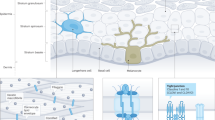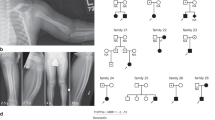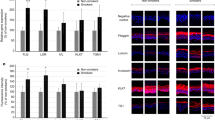Abstract
EHLERS–DANLOS syndrome (cutis hyperelastica, india-rubber skin), a rare heritable generalized disorder of the connective tissues, is characterized by hyperextensibility of the skin, hyperlaxity of the joints, fragility of the skin, and, not infrequently, by one or a combination of such internal manifestations as cardiac anomalies, dissecting aneurysm of the aorta and diaphragmatic hernia1. Previous investigations directed towards identifying the fundamental defect in the connective tissues, using the methods of light and electron microscopy, have led to contradictory results. Many investigators have described an increase in the amount of elastin in the corium while others have observed a normal or even a decreased amount of elastin1. Similar controversy exists over the possibility that the collagen is either quantitatively or qualitatively abnormal in this disease1,2. The purpose of the work reported here was to isolate elastin quantitatively from the skin of patients with this disease and from the skin of normal, control subjects, and to examine chemically the purified elastin isolated from these two sources.
This is a preview of subscription content, access via your institution
Access options
Subscribe to this journal
Receive 51 print issues and online access
$199.00 per year
only $3.90 per issue
Buy this article
- Purchase on Springer Link
- Instant access to full article PDF
Prices may be subject to local taxes which are calculated during checkout
Similar content being viewed by others
References
McKusick, V. A., Heritable Disorders of Connective Tissue, second ed. (C. V. Mosby and Co., St. Louis, 1960).
Wechsler, H. L., and Fisher, E. R., Arch. Path., 77, 613 (1964).
Tunbridge, R. E., Tattersall, R. N., Hall, D. A., Astbury, W. T., and Reed, R., Clin. Sci., 11, 315 (1952).
Jansen, L. H., Dermatologica, 110, 108 (1955).
Thomas, J., Elsden, D. F., and Partridge, S. M., Nature, 200, 651 (1963).
Miller, E. J., Martin, G. R., and Piez, K. A., Biochem. Biophys. Res. Comm., 17, 248 (1964).
Czerkawski, J. W., Nature, 194, 869 (1962).
Rollhäuser, H., Gegeribaurs Morphol. Jahrb., 90, 249 (1950).
Glagov, S., and Wolinsky, H., Nature, 199, 606 (1963).
Author information
Authors and Affiliations
Rights and permissions
About this article
Cite this article
VARADI, D., HALL, D. Cutaneous Elastin in Ehlers–Danlos Syndrome. Nature 208, 1224–1225 (1965). https://doi.org/10.1038/2081224b0
Issue Date:
DOI: https://doi.org/10.1038/2081224b0
This article is cited by
-
Soluble and insoluble collagen and elastin in the rat hair cycle
Archives of Dermatological Research (1979)
-
Histomorphologische Untersuchungen über das destruktive und restitutive Verhalten des Ligamentum parodontale unter kieferorthopädischen Zahnbewegungen
Fortschritte der Kieferorthopädie (1978)
-
Das Ehlers-Danlos-Syndrom aus morphologischer und chemischer Sicht
Virchows Archiv Abteilung A Pathologische Anatomie (1971)
Comments
By submitting a comment you agree to abide by our Terms and Community Guidelines. If you find something abusive or that does not comply with our terms or guidelines please flag it as inappropriate.



